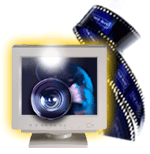Starting with Windows Movie Maker

Looking for an adventure? Say no more. Windows Movie Maker is the exciting new feature in Windows Me that lets you record, store, organize, edit, and share your home movies.
You could be taking meetings in Hollywood or hobnobbing at the Sundance Film Festival before you know it. For novice and even intermediate home computer users, however, your first adventure with Windows Movie Maker could very well be a journey into the heart of your computer.
The wide range of hardware configurations—for both video equipment and home computers—has created an equally wide range of hardware compatibility scenarios. The way your system works with Windows Movie Maker depends on the equipment that you own.
There are essentially only two situations, one based on using your computer and Windows Me with analog video equipment, and the other based on doing the same with digital video equipment.
Analog video equipment
For analog video cameras and VCRs, the all-important interfacing device you are likely to need is an analog USB audio/video capture device, sometimes known as a "dongle." This is a small, simple device that connects to a USB port on your computer and allows you to attach audio and video cables from your video camera or VCR.
Some analog video cameras and VCRs are supported by a video capture card, which you may need to install if your computer doesn’t already have one. Video capture cards can improve the quality of your video as it is converted from analog to digital format, but finding the right one and installing it may require some help from an experienced computer user.
In addition, some video capture cards provide the ability to attach audio and video cables from your video camera or VCR directly to your computer, which means you won't need a dongle. Check your video capture card documentation to find out if this is possible for you.
Digital video cameras
Digital video cameras require an IEEE 1394 connection, which is not currently a standard part of most home computer systems. Consult your system profile to see if your computer has IEEE 1394 capability. If it doesn't, you will need to install an interface card (sometimes referred to as a "firewire" card). To find the right card, you can start by contacting the manufacturer of your computer for information about which cards work with your system. You will also need to contact the manufacturer of your video camera for recommendations on the best IEEE 1394 cards to work with your camera.
Note It's important to find an interface card that works with both your computer and your video camera.
After you have found the appropriate card, you will need to install it, which requires you to remove the casing from your computer and snap the card into place. It's a fairly simple process, but it's probably best to get the help of an experienced computer user.
Hey, who's driving this thing?
Finally, whether your video equipment is analog or digital, you will need a driver to keep all the different parts working together correctly. A driver is a small piece of software that, in this case, allows your video equipment to work with the capture card in your computer. Check the Web site of the manufacturer of your video equipment to make sure the appropriate driver is available. If it isn't, you may need to call or write the manufacturer to find out when it will be available. Many IEEE 1394 interface card drivers are already installed with Windows Me.
Then it's on to the really fun adventures
Now you can begin to enjoy all the great features of Windows Movie Maker, which makes it fun and easy to create your own digital movies and share them with friends and family on your computer, on the Web, or by e-mail.
|
